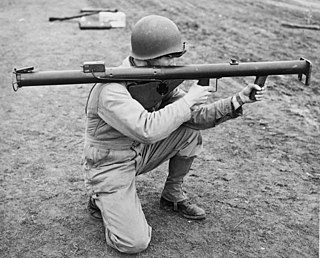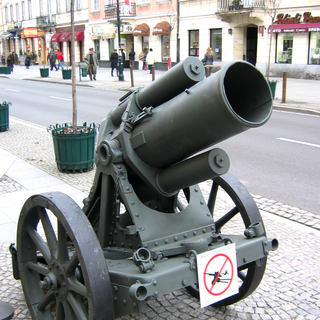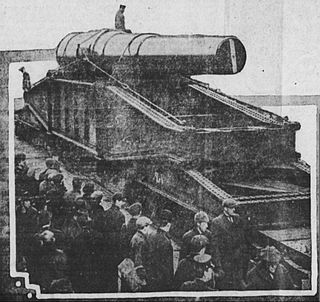
Bazooka is the common name for a man-portable recoilless anti-tank rocket launcher weapon, widely deployed by the United States Army, especially during World War II. Also referred to as the "stovepipe", the innovative bazooka was among the first generation of rocket-propelled anti-tank weapons used in infantry combat. Featuring a solid-propellant rocket for propulsion, it allowed for high-explosive anti-tank (HEAT) shaped charge warheads to be delivered against armored vehicles, machine gun nests, and fortified bunkers at ranges beyond that of a standard thrown grenade or mine. The universally applied nickname arose from the M1 variant's vague resemblance to the musical instrument called a bazooka invented and popularized by 1930s American comedian Bob Burns.

A mortar is usually a simple, lightweight, man-portable, muzzle-loaded weapon, consisting of a smooth-bore metal tube fixed to a base plate with a lightweight bipod mount and a sight. Mortars launch explosive shells in high-arching ballistic trajectories. Mortars are typically used as indirect fire weapons for close fire support with a variety of ammunition.

The formal definition of large-calibre artillery used by the United Nations Register of Conventional Arms (UNROCA) is "guns, howitzers, artillery pieces, combining the characteristics of a gun, howitzer, mortar, or multiple-launch rocket system, capable of engaging surface targets by delivering primarily indirect fire, with a calibre of 75 millimetres and above". This definition, shared by the Arms Trade Treaty and the Treaty on Conventional Armed Forces in Europe, is updated from an earlier definition in United Nations General Assembly Resolution 46/36L, which set a threshold of 100mm. Several grammatical changes were made to that latter in 1992 and the threshold was lowered in 2003 to yield the current definition, as endorsed by UN General Assembly Resolution 58/54.

The Krupp K5 was a heavy railway gun used by Nazi Germany throughout World War II.

Schwerer Gustav was a German 80-centimetre (31.5 in) railway gun. It was developed in the late 1930s by Krupp in Rügenwalde as siege artillery for the explicit purpose of destroying the main forts of the French Maginot Line, the strongest fortifications in existence at the time. The fully assembled gun weighed nearly 1,350 tonnes, and could fire shells weighing 7 t to a range of 47 km (29 mi).

The Parrott rifle was a type of muzzle-loading rifled artillery weapon used extensively in the American Civil War.

The T28 Super Heavy Tank was an American super-heavy tank/assault gun designed for the United States Army during World War II. It was originally designed to break through German defenses of the Siegfried Line and was later considered as a possible participant in the planned invasion of the Japanese mainland.

A railway gun, also called a railroad gun, is a large artillery piece, often surplus naval artillery, mounted on, transported by, and fired from a specially designed railway wagon. Many countries have built railway guns, but the best-known are the large Krupp-built pieces used by Germany in World War I and World War II. Smaller guns were often part of an armoured train. Only able to be moved where there were good tracks, which could be destroyed by artillery bombardment or airstrike, railway guns were phased out after World War II.

The BL 4.5 inch medium gun was a British gun used by field artillery in the Second World War for counter-battery fire. Developed as a replacement for the BL 60-pounder gun it used the same carriage as the BL 5.5-inch medium gun but fired a lighter round further.

The 75 mm gun, models M2 to M6, was the standard American medium caliber gun fitted to mobile platforms during World War II. They were primarily mounted on tanks, such as the M3 Lee and M4 Sherman, but one variant was also used as an air-to-ground gun on the B-25 Mitchell medium bomber aircraft. There were five main variants used during the war: M2, M3, M4, M5 and M6.
The Landkreuzer P 1500 Monster was a purported German pre-prototype super-heavy self-propelled gun designed during World War II. While it is mentioned in a number popular works about World War II projects, there is no solid documentation for the program’s existence, and it may have only been a semi-serious proposal, or even an outright hoax.

The 240 mm howitzer M1, popularly nicknamed the "Black Dragon", was a towed howitzer used by the United States Army. The 240 mm M1 was designed to replace the World War I era 240 mm howitzer M1918, which was based on a 1911 French design and was outdated by World War II.

The 17 cm Kanone 18 in Mörserlafette, abbreviated as 17 cm K 18 in MrsLaf was a German heavy gun used during World War II.

The 240 mm trench mortar, or Mortier de 240 mm, was a large calibre mortar of World War I. An original French design, it was developed by Batignolles Company of Paris and introduced in 1915.

The 25 cm schwerer Minenwerfer, often abbreviated as 25 cm sMW, was a heavy mine shell launching trench mortar developed for the Imperial German Army in the first decade of the 20th century.

The QF 6 pounder Nordenfelt was a light 57 mm naval gun and coast defence gun of the late 19th century used by many countries.

The 16"/50 caliber Mark 2 gun and the near-identical Mark 3 were guns originally designed and built for the United States Navy as the main armament for the South Dakota-class battleships and Lexington-class battlecruisers. The successors to the 16"/45 caliber gun Mark I gun, they were at the time among the heaviest guns built for use as naval artillery.

In artillery, caliber or calibre is the internal diameter of a gun barrel, or, by extension, a relative measure of the barrel length.

The 16-inch coastal defense gun M1895 was a large artillery piece installed to defend major American seaports. Only one was built and it was installed in Fort Grant on the Pacific side of the Panama Canal Zone. It was operated by the United States Army Coast Artillery Corps.




















